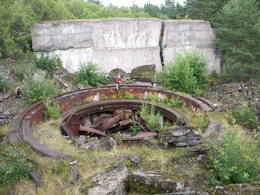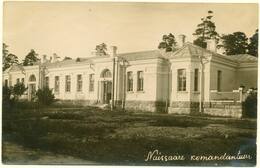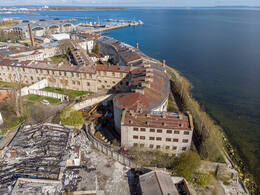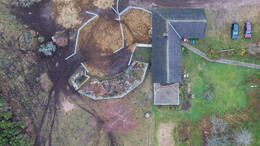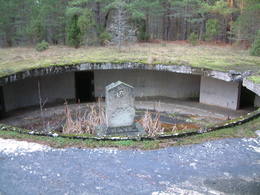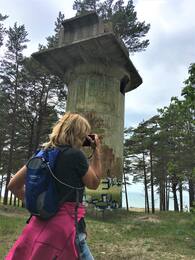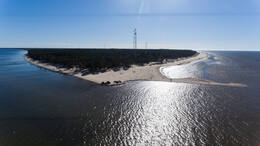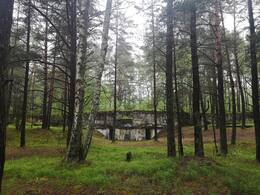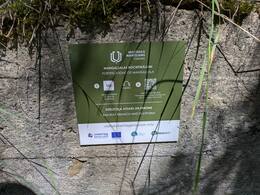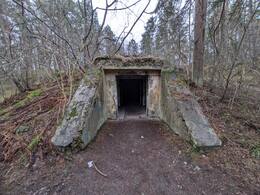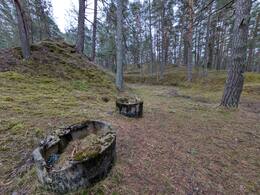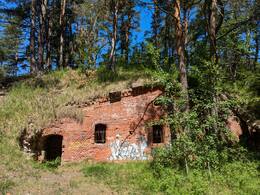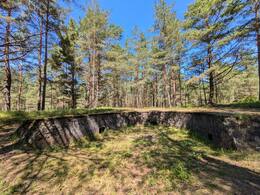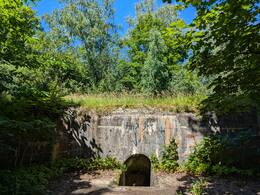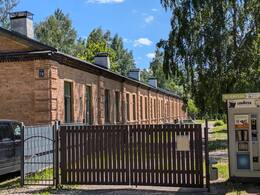Coastal Defence I World War I, II World War II
Coastal Defence is a collection of military measures for the defence of the territorial waters and ship routes near the coast, the coastline and the ports and facilities of military importance near the coast against naval ambushes and other hostilities. Coastal defence is carried out by the corresponding branches of the army and the navy.
The importance of coastal defence rose with the widespread adoption of firearms – battery tower Fat Margaret was tasked with defending the coast. A modern system of coastal defences and bastions were planned in Tallinn during the Swedish Era. With the evolution of armaments, the bastion system became obsolete and, after the Crimean War (1853-1856), Tallinn was decommissioned as a fortified city of the Russian Empire.
Related objects
Aegna Island
The three square kilometres of this island in the north-eastern corner of Tallinn Bay are the site of an extensive network of coastal defence batteries and a three-kilometre narrow-gauge railway built before World War I as a continuation of the fortification work begun by Peter the Great in the 18th century. Construction of the Alexander Nevsky Battery began in 1915. The 180-metre concrete structure was coupled at both ends with barbettes supporting two 12-inch guns each. The guns at the eastern end were higher than at the western end, allowing them to be fired westward over the other guns. Battery No. 3 was built on the western shore of Aegna and was ready for combat by autumn 1916. The battery was first planned to have six 130-mm guns, but in the end it was only equipped with four.
In 1918, following the declaration of the independence of Estonia, the coastal defences were taken over by the Estonian Navy. The island had residential housing, barracks, an officer’s mess, staff headquarters, a bread factory, a library, a clinic, a bathhouse and more. The command centre on the island was completed in 1927 in Eerikneeme. Battery No. 10 was also completed that year, equipped with three 75-mm anti-aircraft guns (with a barrel length of 3.75 m) capable of firing up to 6 km in altitude. The importance of Aegna in the coastal defence of Estonia is reflected in the fact that, at its peak, half the men serving in the Naval Fortress Division were stationed on the island. The existing infrastructure enabled the locals to manage on their own in winter, since disruptions to sea traffic were common.
After World War II, the Soviet Navy Baltic Fleet Air Defence branch, consisting of around 100 marines, was stationed on Aegna until 1957. A new anti-aircraft battery made up of four concrete gun pits 45 metres apart were constructed near the Alexander Nevsky Battery searchlight bunker in the north-western part of the island. Bofors 40-mm guns formerly used by the Estonian military were installed. Due to the Estonian coastline being a restricted area during the Soviet era, travelling to Aegna only became possible again in the 1960s. Traces of different military periods are still clearly visible on the island.
Naissaar
This island, which covers 19 square kilometres in the Bay of Tallinn, was acquired by the Imperial Russian Navy in 1912, forcing out the locals. The navy built ports, railways and coast batteries as part of Peter the Great's Naval Fortress on the island. During World War I and the War of Independence, the island also held a prisoner-of-war camp. The newly independent Republic of Estonia retained the island as part of the established coastal defence system, but allowed the locals to return to it. During the Soviet occupation, the island was under the control of the military, who built a naval mine depot and factory there. The buildings and equipment left behind on Naissaar by the Soviet Army can still be partially explored today. The network of bunkers designed to form the naval fortress goes deep underground. Some of the bunkers and artillery mounts are still accessible. A full tour of the island can be taken in a day. The island used to be covered with a dense railway network connecting the military facilities. This is why the remaining tracks are a great trail guide for touring the island.
Naissaar is home to 40 kilometres of narrow gauge railways, the laying of which began in 1913 during the czarist era. The railway network was also partially used during the era of independence and during the Soviet occupation. Today a 2.4 kilometre segment of it has been restored. The Museum of Coastal Folk has various exhibitions on display for visitors to the island providing a more elaborate overview of the island's history. A military exhibition is on display in the Soviet-era career soldiers' living quarters in Männiku village, which showcases both the island's earlier and more recent military past. Naissaare lighthouse is hosting an exhibition called 'Naissaar on old postcards', which depicts the island during its heydays.
Patarei Naval Fortress
A former naval fortress located in the Kalamaja district of Tallinn.
Designed by military engineers Étienne-Louis Boullée and Claude-Nicolas Ledoux, Patarei was commissioned in 1829 by Russian Emperor Nicholas I. The complex was opened in 1840, but this did not mean that construction work was complete. The fortress underwent renovations: there were fears that the British and French would attack from the Baltic Sea after the outbreak of the Crimean War in 1853. This did indeed come to pass, but it did not escalate into large-scale warfare. Only a few shots were fired from Patarei. As a result of the adoption of explosive projectile, Patarei was decommissioned as a fortress in 1858 and was thereafter used as barracks. During the era of Estonia’s independence, Patarei was turned into a prison, which operated until 2002. It had also been used as a prison during the German and Soviet occupations. The atrocities committed there by those regimes made the place infamous among the population. The architecturally prominent building, which covers four hectares, is now home to an exhibition entitled ‘Communism is Prison’, which shines the spotlight on communist ideology, communist crimes and the history of the building. Renovations of this remarkable architectural wonder covering four hectares began in 2020. By 2026 Patarei shall be an integrated urban landscape complete with commercial space, living quarters and leisure options. The original prison interior and exercise yards shall be preserved in the eastern wing of the building. Already there's an exhibition on the communist ideology and atrocities and the history of the building covering close to 1200 square metres.
The 12-Inch Coastal Battery at Tahkuna (no 39)
According to various plans of the naval defence system of St. Petersburg, up to fifty coastal batteries were to be built on the Estonian coast. There were three 14-inch batteries planned but none were completed. There were six 12-inch batteries planned but just four were completed: in Aegna, Naissaar, Sõrve and Tahkuna.
As the original plans had outlined no batteries on the islands, the war-time construction work was hastily carried out according to simplified drawings – unarmoured artillery was positioned uncovered on round concrete platforms (diameter 15 m, height 2 m, depth of foundation 4.5 m). Only about a tenth of the concrete work got completed in Tahkuna. Four guns are positioned in two pairs, the distance between guns is 64 m. In June 1917 the guns were mounted on the platforms and test shootings were carried out. In the autumn the battery was reported to be battle-ready, although the installed range finder was small and would not let the battery shoot accurately at maximum distance. The battery was manned by 220 soldiers.
The length of the 12-inch gun barrel was 15.8 m, the weight was 50 tons. The weight of a shell was 450 kg, with the explosive charge up to 156 kg. The maximum shooting range was 28 km. The lifetime of the barrel was 300 shots, then the barrel needed to be replaced. The battery of Tahkuna was the only 12-inch Estonian battery where the guns remained intact although according to the report of the destruction crew, the guns had been destroyed. The barrels were taken to Naissaar in the early 1920s for the renovation of its battery but this work was never completed. From Naissaar one spare barrel was sold to Finland in 1934.
Today all four gun platforms survive in Tahkuna, demonstrating stages when the construction work must have been interrupted. The third position is the most complete. The gun platforms have been exposed to weather for over a century, nevertheless, the concrete is in excellent condition and all bolt circles are complete. Only a layer of moss covering the concrete gets thicker each year and the surrounding forest gets denser. Behind the gun platforms in the woods there are plenty of remains of shelters and trenches, a couple of concrete foundations, a recognizable railway dam and drainage ditches. About 200 m Southeast of the first gun platform there is a large crater of a blown up ammunition cellar.
120-mm Battery No 34 at Hindu (Sõru)
The construction of the battery began in 1914. As it was an additional battery, missing in the original plan of the naval fortress and the type of guns was repeatedly changed. Finally four 120- mm Vickers guns were installed. A 200-m length and 10-20-m width sandbar was piled up in defence of the gun emplacements and covered in concrete above the guns. Hindu was the only battery in Hiiumaa that participated in combat operations during the Tagalahe landing on 12 October 1917. After a brief exchange of fire with the German warships the Russian artillerymen fled, leaving the battery intact. The Germans sent a landing unit of soldiers inland that blew up the guns of the battery. One of the German warships that shot Hindu battery, was ’Bayern’, the warship with the largest displacement that has ever been in the Estonian waters (length 180 m, displacement 32 200 tons, eight 380-mm guns).The building of the battery radio station was transported to Emmaste and was used as the community centre (demolished in the 1980s). The gun barrels and other larger details were still there in 1937. Today the first and the second gun platforms are still identifiable, the other two are situated on a fenced farmyard. The third gun crater is filled with earth and there is a newly built house facing the sea, the remains of the fourth one is merely a cracked concrete platform. Out of two air defence gun platforms, one survives (a hundred metres toward the nursing home, on the right side of the road). There are no intact buildings. The machine gun bunker between the first and the second emplacement was completed in 1941.
Concurrently with the construction of Hindu battery, there was a plan to build something in Lepiku village where large gravel bars were piled up, still visible today. It is unknown what the building was going to be.
317th 180-mm Coastal Defence Battery in Ninase
This coastal defence battery is situated in Ninase near the Port of Saaremaa on Tagaranna Peninsula. Following the outbreak of World War II, the Soviet Union began fortifying the Western Estonian Archipelago and a coastal defence battery comprising four 180-mm guns was built on farmland in the village of Ninase to deter the enemy. Construction work on the battery began in July 1940. Its artillery stood 200-300 metres apart, with a generator established nearby to supply the complex with electricity. The battery was not used in combat. On 20 September 1941, German troops surrounded the battery. The battery crew managed to blow up two of the guns and break through the German line.
Ninase Coastal Defence Battery is one of the best preserved historical buildings from World War II on Saaremaa and has turned into a popular tourist attraction. It has become more attractive in recent years thanks to the Mustjala Music Festival, which is held nearby.
Rangefinder No.1 of the 23rd Shore Battery (1941)
The rangefinders (dating from 1941) are located in the pines of the dune, only 10m from the other tower, built in 1954. The 1st and 2nd gun emplacements of the shore battery are located on the seafront and partially eroded, while the 4th gun emplacement is best seen in the dunes. The reinforced concrete bunker of the personnel who manned the guns is now washed away by the waves and has a washed-out foundation, tilted and leaning seawards.
Liepaja Fortress Battery 2 was planned to be built further from the shoreline and protected by a high rampart. The armament of the battery was to be 16 11-inch (280 mm) mortars of the 1877 model. The mortars used steep trajectories and did not require direct aiming.
Following the 'base agreement' between the Republic of Latvia and the USSR, signed on 5 October 1939, a contingent of nearly 25 000 Red Army and Baltic Navy troops was to be stationed in Kurzeme. By March 1941, Baltic naval bases were established in Latvia in the defence sectors of Irbe Bay, Saaremaa and Liepāja, consisting of coastal defence batteries.
The Liepaja coastal defence sector included the 208th artillery division with two 130 mm B-13 gun batteries (No 23 and No 27) and one 180 mm rail gun battery. Construction of Battery 23 began in November 1939 and was completed on 17 May 1941, partly using the reinforced concrete fortifications of Battery No. 2 of Liepaja Fortress. Battery 23 consisted of four reinforced concrete gun positions on the seafront, a command post and an observation (range-finding) tower in the dune forest. The range-finding positions were located in reinforced concrete towers to ensure better visibility while maintaining concealment in the pine forest.
After the Second World War, Battery 23 was renamed Battery 636, armed with the same 130 mm B-13 guns, and a new range-keeping tower was built for fire control in 1954, adjacent to the 1941 tower. In 1963, all the Liepaja coastal defence guns were dismantled.
After the restoration of Latvia's independence, the area of Battery No 2 is in the use of the Ministry of Defence.
German army coastguard searchlight site in Usi and border guard post in Kolka
No military infrastructure was planned in Cape Kolka, except for several offshore lighthouses that were rebuilt over a long period of time, either before World War I, during World War I or during World War II. Coastal defence batteries were planned for the narrowest part of the Irbe Strait, between the Sirves Peninsula and the Michael Tower Lighthouse.
The only fortifications of a military nature appeared at the end of 1944, when the German Army Group North was preparing to repel possible landings by the Soviet Baltic Fleet. In the spring of 1945, after the ice retreated, two batteries of the 532nd Artillery Division defended the coast at Cape Kolka. Battery 7 with four 75 mm guns and three 20 mm zenith guns. Battery 8 with four 88 mm mortars, three 20 mm mortars and an 81 mm mortar. The anti-deserter infantry garrison consisted of one of the most famous coastal defence units of the German Navy, the 5th Company of the 531st Artillery Division. Although it was an artillery unit by name, it was an infantry unit by deployment, which started its war in June 1941 at Liepāja. The unit was then garrisoned on islands in the Gulf of Finland and later took part in the fighting on the island of Saaremaa. The remnants of the division were reformed into one company and, reinforced with seven anti-tank guns and three 20 mm anti-aircraft guns, deployed at Cape Kolka.
The Soviet naval landing operation never took place and the German units capitulated in May 1945.
The military infrastructure in Cape Kolka began to be built after the Second World War, when Soviet border guard posts were deployed here and Kolka, like the entire Kurzeme coast from Mērsrags to the Lithuanian border, became a closed zone
Mangaļsala fortifications
Coastal fortifications are located in Riga, Mangaļsala, at the mouth of the Daugava across from Daugavgrīva. Fortifications built by different armies (Russian, Latvian, German and Soviet) can be seen here. The fortifications of Mangaļsala were built to defend the city of Riga from hostile navies. This area was strategically important for a long period of time. After World War I the Latvian Army did not yet have a strong navy. The maritime border was long and coastal defence was becoming an increasingly difficult task. The Latvian Army took over the fortifications built by the Russian Empire in the end of the 19th century and beginning of the 20th century and expanded the defence system. The artillery of Daugavgrīva and Mangaļsala would open fire on enemy ships trying to enter the mouth of Daugava, while support points at the mouth of Lielupe (Jūrmala) and mouth of Gauja (Carnikava) would stop enemy landing parties. There was also a specially equipped armoured coastal defence train that could provide artillery fire and support in the direction of Saulkrasti or Jūrmala. The aim of fortifying strategic sites was to maximise the use of weapons through special constructions and terrain advantages. Coastal defence fortifications were spread out over a large area to counter enemy efforts in the event of war.
Audio guide https://izi.travel/en/edbf-mangalsala-fortifications/en
Railway branch and platform
Around 1958, a special railway branch was built on Mangaļsala from the Vecāķi station for the needs of the Soviet army. It was the most convenient way to bring fuel, ammunition, firearms and building materials to the military base located here. Even earlier, starting from the 20th century and up to the Soviet years, a narrow-gauge railway ran through the entire Mangaļsala, transporting ammunition to the gun emplacements. Later, a more serious railway branch was built, crossing the Vecdaugava over one of the two – the least known – dams on Mangaļsala. For example, it is no longer possible to access this dam from the Vecāķi side, because the view is blocked by private property. The concrete hillock visible in nature was a platform. When Soviet troops left Latvia in the early 1990s, 600 wagons with approximately 30 tons of ammunition were transported along this railway. It is said that at that time it was done in such a hurry and so carelessly that "the whole of Riga could have been seen in the air". Or at least a certain Riga neighborhood. Shortly afterwards, the railway was dismantled.
Closed ammunition depots built in the 1950s
In the 1950s, such a bunker was built and covered with earth so that a potential enemy could not find it so easily. There are four such buildings in Mangalsala in total, all of which were built between 1953 and 1955. During the Soviet era, ammunition was stored here - underwater mines, torpedoes, etc. Currently, this is the cleanest of the closed-type ammunition depots from the Soviet era, but if you go further, you can also see the largest one.
Attention! To protect hibernating bats (all species are protected), do not move underground and inside bunkers from October to April.
Open ammunition depots, lightning conductors, wells
During the Soviet era, so much ammunition and military equipment was brought to Mangaļsala that there was not enough space in the warehouses, so a large part of it had to be stored in the open air. Only such things that could be damaged by moisture were placed in the premises. This action also shows the careless attitude of the Soviet army towards any kind of inventory: a sandbank was built around it, of which a small hillock still remains, but the bank itself protected the ammunition from fires and explosions. If a rocket were to explode in the vicinity here, the blast wave would hit the bank and would not reach further, or would reach a much smaller extent. Nearby is a reinforced concrete pole - a lightning rod! Such poles allowed to protect ammunition from lightning strikes. Similar poles can be observed in other places. Former water wells are also visible, so that if necessary, something could be extinguished. In general, information about the Mangalsala ammunition depots was very secret - even on old Soviet military maps these places are marked as pioneer camps. Approximately 50 meters behind the embankment is another concrete bunker.
Projectile warehouses
This building was built between 1876 and 1885, when Tsar Alexander II and after him Tsar Alexander III ruled here. It is worth paying attention to the facade of the building with cornices and window openings, etc. decorative forms. This building was used as a warehouse where cannon shells were stored. Approximately 300 meters from here there is another such warehouse, which even has beautiful, curved window grilles. Similar red brick military buildings can still be found here and there in Latvia - for example, in Liepāja Karosta. All the red brick buildings on the territory of Mangaļsala were built at about the same time. At that time, the political situation in Europe was complicated, and the Russian Empire began to militarily strengthen its Western border. The building has a double outer wall and air circulates between the walls, which not only creates additional ventilation, ensuring the necessary temperature and humidity level in the building, but is also able to cushion the explosion. In the event of a large explosion, the outer wall collapses, but the inner one remains intact, protecting what is inside the building. On top of the bunkers on the other side of Mangaļsalas Street, there were mortar positions. During the time of free Latvia – in 1926 – anti-aircraft guns, or cannons that move on wheels, were placed instead of mortars! Not far from here is one of the thickest pine trees in Riga. Moreover, it is not only thick and large, but also wounded – bullet marks can be found on the pine trunk. In what battles the pine suffered – it is unknown!
Attention! To protect hibernating bats (all species are protected), do not move underground and inside bunkers from October to April.
Chemical warehouse and bypass road
This bunker was built in 1955 – during the Soviet occupation. The path around this building was once a bypass road, surrounded by a double barbed wire fence. Guards walked behind it and watched to see if any unauthorized person approached the facility. This building is mentioned in some sources as an ammunition depot, and in others – a chemical storage facility. It is said that there were even nuclear missiles here, but no traces of radiation have been found here. It is completely dark inside, but then, light is visible. It was once a ventilation system. This is the only building on Mangalsala that had ventilation. Cargo was brought here by wagons along the railway. The acoustics are very good – once a youth choir even had a rehearsal here! However, here and there, graffiti art works are placed on the walls of the building.
Attention! To protect hibernating bats (all species are protected), do not move underground and inside bunkers from October to April.
Latvian Army Spotlight Point
The peculiar horseshoe-shaped concrete structure was once the location of a searchlight. Meanwhile, a hundred meters further towards Vecāķi, a searchlight helmsman sat in a small concrete bunker and watched for any unauthorized person approaching from the coastal side. There were practically no trees here, so the entire area was clearly visible. If an attacker started shooting at the light source, the helmsman would be completely protected – submerged in the cover of darkness and concrete. This searchlight point was built by the Latvian army in 1928, continuing to adapt the already militarized Mangaļsala to its needs. Later, during the Soviet occupation, the searchlight could also be used to watch for anyone intending to go in the opposite direction and flee to the “wild west”. Leaving the country without permission was prohibited. In addition to security, the coastal sand was also plowed up so that the tracks of illegal immigrants or pedestrians could be seen.
Coastal artillery battery
This is the largest military structure on Mangalsala, which began to be built between 1912 and 1916. The walls of the bunker were several meters thick, and it was protected from the sea by a sandbank. During the First World War, the German fleet did not come to Riga, only thanks to the cannons stationed here. In 1917, the Russians withdrew from Riga on their own and blew up part of the bunker when they left. During the Latvian Independence period – in the 1930s – and later during the Soviet years, this battery was renovated and expanded – the cannon platforms were rebuilt and new cannons were installed. In 1941 – during the Second World War, the Russians blew up this battery again, fearing that German troops might enter Latvia. The first cannons fired approximately 12 to 15 kilometers, but the newer ones could hit the target at a distance of up to 40 kilometers. There is an inscription: “Built by sailors” - built by sailors in 1946. In the basement of the bunker there were ammunition cellars, where the shells needed for the guns were stored. There were special hatches in the walls through which shells could be fed for faster loading of the guns in combat conditions. Now here is the longest military tunnel on Mangalsala - a corridor about 100 meters long. In the spring, part of the bunker tends to flood! In the 1960s, aviation technology developed, missiles and air defense systems were invented, and this battery with all its guns - once so scary and powerful - became unnecessary to anyone.
Attention! To protect hibernating bats (all species are protected), do not move underground and inside bunkers from October to April.
Army town
In this neighborhood, in the late 1920s and early 1930s, the Latvian army built an army camp for officers and soldiers who worked on Mangalsala. Later, the camp, along with the Mangalsala military base, became the property of the Soviet Union. Civilians without a certain status lived here, but later social apartments were created for low-income people. On the right side there was a football field and small gardens, but over time they turned into meadows and swamps. Later, private houses and a car service appeared here. Until the 1960s, Mangalsala was not part of Riga at all, but part of Mangali parish. At that time, people here were engaged in fishing or worked at the army base, because agriculture was practically impossible – the area of arable land on Mangalsala is only 3.8%. Once upon a time, a narrow-gauge railway ran through the camp right along Mangalsala Street, but the street itself was paved. Now the pavement is hidden under a layer of asphalt. At the end of the road is the port area and the former military pier. Army ships were once moored there, and footbridges were built between them.
Can be seen from the outside, walking along Mangaļsalas Street.
Fortifications of the Daugava River Mouth
The fortifications of the Daugava River mouth are the oldest structures on Mangaļsala. Here you can see the entire 400-year history of the island's military heritage, as well as examples of military architecture from several periods - the Swedish era, the Tsarist era, the era of free Latvia and the Second World War. The first gun positions on ancient maps in this area appear as early as the 17th century with the construction of the Daugavgrīva fortress, but later the fortifications were gradually expanded and renovated. During the Swedish era, dolomite was transported here by barges along the Daugava from the Koknese quarries for the construction of tunnels and gun positions. In the mid-19th century, piers began to be built in the Daugava. About twenty or thirty years later, red brick bunkers began to be built here. Two of the reinforced concrete gun positions were built already during the period of the Independent State of Latvia - in 1934, as evidenced by the engraving made with a finger or a branch in the concrete. Moving east, you can see anti-aircraft gun positions built by German troops during World War II. This is the only place on Mangalsala where real hostilities took place – during the Crimean War in the mid-19th century, the British fleet attacked Riga, but thanks to the fortifications of the Daugava estuary, the attack was not very successful. Half a century later – on July 2, 1919 – during the Latvian War of Independence, Estonian gunboats from the coast successfully fired on the positions of the German Iron Division on Mangalsala. During World War I, the fortifications of Daugavgrīva were so formidable that Riga was the only city on the Baltic coast that the German fleet avoided launching hostilities against. So, these Daugavgrīva fortifications have protected the port gates for centuries, preventing the enemy from entering Riga.
Attention! To protect hibernating bats (all species are protected), do not move underground and inside bunkers from October to April.
Eastern (Mangalsala) Pier
Both piers on the Daugava are closely connected with military events and history. They were built at the end of the 19th century to reduce the clogging of the river mouth and regulate the flow, thereby ensuring shipping and at the same time - the protection of the Daugava mouth. Their strategic importance was associated with the protection of Riga as an important port and military base.
During World War I and the Latvian War of Independence, the area around the mouth of the Daugava River was a zone of military operations. During World War II, the piers were of great strategic importance, as they helped control the approach to Riga from the sea.
The pier is based on a wooden pile structure covered with stones. The pier is approximately one kilometer long.
Although today the Daugava piers are mainly used as a walking area and a historical site, their historical connection to military strategy and the protection of sea routes is an important aspect of Latvian history.
Caution! The surface of the pier can be slippery. Visiting it during strong winds and storms is dangerous!
Riga Garrison Army Tent Camp
Now there are bushes and thickets here, but in the thirties of the last century, the Riga garrison army summer camp was located here. In some places you can still see what look like rectangular ramparts. In these places there were soldiers' tents, arranged in four long rows, with small streets in the middle. At the ends of the rows stood the logos of the garrison units - they were cast from concrete, but the ornaments and inscriptions were made of small, colorful stones. The ramparts around the tents were necessary not only to retain moisture, but also for military purposes. If landing troops entered Mangaļsala, they would be used as trenches under the cover of which to protect the territory from the enemy. Although real military training was taking place here, a romantic idyll reigned in the air, which is also visible in photographs of the time. Young people played volleyball. In the courtyards of the officers' cottages, gazebos and flower beds were well-groomed. The soldiers were visited by their loved ones on weekends, bringing baskets of strawberries and fresh bread. Most meals were eaten outside at tables in the fresh air.
Related stories
Sääre Coastal Defense Battery No. 43
As early as 1907, Russia began making preparations to develop forward defensive positions for its capital, St. Petersburg.
Memories of the border zone
Various scenes from life during the Soviet era, as remembered by Gunārs Anševics, a writer, prose and poetry author, while living in the border zone.
In the footsteps of a spy
People's memory is sometimes quite short. Now, when everyone can go and go wherever they want, many cry about the lost cheap sausage, but they have already forgotten that right behind Mērsrags, in front of the road, a striped bomb often landed and armed Russian soldiers, called border guards, let them through only with written and stamped passes. And not just any resident of the Latvian SSR could receive a permit, but only those who had first received a so-called summons from the Roja or Kolka village council, on the basis of which, after ten days, they could (or could not) receive a visa for entry into the prohibited border zone at their militia unit. I had bought a house on this unfortunate coast of Kurzeme, so every spring I and my family members had to pray and humble themselves so that the authorities would renew the entry permit.
"The Latvian SSR NPP will be here!"
Memories of Andris Zaļkalns (born 1951, Chairman of the Council of People's Deputies of the village of Vērgale (1982-1989)) about the time when a nuclear power plant was almost built in Akmeņrags.
Nature photos of the Uzava coast and Soviet border guards
The story of a protected plant photo in a border guard area.






